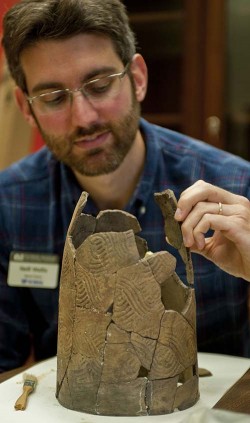Florida Museum of Natural History researcher Neill Wallis recently received a $55,000 National Science Foundation grant to analyze and digitally document pottery made by prehistoric people of the Deep South.

Florida Museum photo
The grant will help Wallis analyze Swift Creek Complicated Stamped pottery used by hunter-gatherers of northern Florida, Georgia and eastern Alabama from A.D. 100 to 800. Wallis began the project this summer with $20,000 from the Wenner-Gren Foundation used to conduct neutron activation and petrographic analyses. The three-year NSF grant will fund preparation of the vessels, database development, travel expenses, photographing the designs and radiocarbon dating soot on the pottery.
The research will expand the work Wallis conducted for his book, “The Swift Creek Gift: Vessel Exchange on the Atlantic Coast,” published in February. Featured in April by the Smithsonian National Museum of the American Indian Library, the book showed significance could be found in seemingly meaningless items, such as cooking pots that were found to be exchanged long distances.
The creation of an online database of the material will help researchers distinguish and analyze population migration patterns, marriage alliances and exchange. Wallis said he hopes to compile at least 40 radiocarbon dates in pottery collected from 24 sites.
“The radiocarbon dating will be extremely valuable because we don’t have that many dates for Swift Creek for the middle-to-late Woodland period,” Wallis said. “That will be helpful for just tying down the chronology while looking at all these sites.”
Swift Creek pottery is unique because artifacts sharing the same impressions, created by stamping a paddle into a vessel before it is fired, can be traced to specific sites. The designs are like “fingerprints,” enabling researchers to map where ancient people lived, the distances they traveled and with whom they interacted, Wallis said.
The samples are from the Woodland period, which spanned 1,000 B.C. to A.D. 1,000, a time of considerable cultural development and increased burial mound ceremonialism, Wallis said.
“Around 1,500 years ago, people were organized in ways we don’t understand that well,” Wallis said. “At a level of social organization somewhere between large chiefdoms and small bands of hunter-gatherers, anthropologists don’t have a very good idea of how those people interacted or how exchange or mobility shaped their society. This pottery allows us to establish patterns in the movement of ancient people or the movement of objects in ways no other artifacts can.”
About one-third of the samples used for the project are housed in the Florida Museum’s collections. Other contributors include the Florida Bureau of Archaeological Research, the University of South Florida, the University of Georgia and Valdosta State University. The project responsibilities and total NSF award of $87,000 is shared with University of South Florida anthropologist Thomas Pluckhahn.
“This will be useful to many archaeologists working in Florida, Georgia or Alabama – there are a lot of sites that have Swift Creek pottery,” Wallis said. “It’s really going to give us a sense of how hunter-gatherers interacted with other hunter-gatherers.”
Learn more about the Florida Archaeology Collection at the Florida Museum.